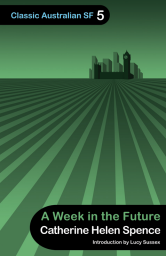A Week in the Future
Classic Australian SF 5
by Catherine Helen Spence
Chimaera Publications
Review by Russell Blackford
A Week in the Future by Catherine Helen Spence (first published in serial form 1888-89) is the fifth volume in the Classic Australian SF series—the order of the volumes does not reflect the dates of original publication.
This short book is a socialist-feminist utopia, and like most pure utopias suffers from a lack of narrative richness and drama. Instead, it works somewhat like a travelogue.
In late middle age, the narrator—Emily Bethel—learns that she is unlikely to live for more than another two years. Her family and her doctor advise her to adopt a life without worry or strong emotions, but that is anathema to her. She would rather have one week in the future, enabling her to see the outcome of the social and intellectual movements of her time, than two uneventful and boring years in the present. Her doctor, who is evidently something of a master of occult learning, grants her wish, and she finds herself in the London of 1988.
Over the following seven days, Emily is introduced to the future’s arrangements in housing, industry, child-rearing and education, marriage, government, recreation and the arts, and religion and morality. She learns that competition and conflict have been virtually eliminated from society, along with poverty and the class system, and that far greater social benefits and individual happiness are produced through various cooperative arrangements. The people of this world live longer, enjoy better health, and have increased hours of leisure. Contraceptives are employed to keep the population in check, and relations between the sexes have been revised to make both marriage and divorce relatively easy. Perhaps most notably, from the viewpoint of the novel’s original audience, women and men are considered equals, and all positions in society are open to both.
Unfortunately, books such as this show the weakness of purely utopian narrative. A lack of conflict can result in a lack of interest for readers. For Spence’s original audience, of course, the proposed social arrangements were an interesting and radical option, but for us, over 100 years later, some have already been implemented (to some extent or other), while others appear unrealistic or undesirable… or seem rather quaint because we have already embraced far more radical alternatives. As a result, the book is mainly of historical interest, whereas an unashamedly melodramatic adventure story, such as Guy Boothby’s tale of the menacing Dr Nikola, still provides entertainment and suspense.
Since Spence’s time, writers of utopian fiction have adapted and enhanced the utopian form by inventing new narrative structures that reintroduce an element of conflict—as with Samuel R Delany’s Triton (also known as Trouble on Triton), in which an egotistical misfit is unable to find happiness even in a utopian society, or Ursula K Le Guin’s The Dispossessed, which is patterned more like a dystopian novel: the ideal anarchist society has stultified to a point where it is needs revitalisation and is seen as grinding the protagonist down.
Such narrative innovations were, alas, a long way in the future when Spence was writing. Still, the book does have the historical interest that I mentioned, as well as the virtue of brevity. You could knock it over in a couple of hours and gain some insight into utopian thinking around the time when the first recognisable science fiction was appearing in Western countries, including Australia. This kind of utopianism was critical in the rise of science fiction, in Australia and elsewhere, and we’ll see a very different version of it when we come to Erle Cox’s Out of the Silence, possibly the greatest work of early Australian science fiction.
Next issue of Aurealis, I’ll review the last book in Chimaera Publications’ Classic Australian SF series, Out of the Silence by Erle Cox.

